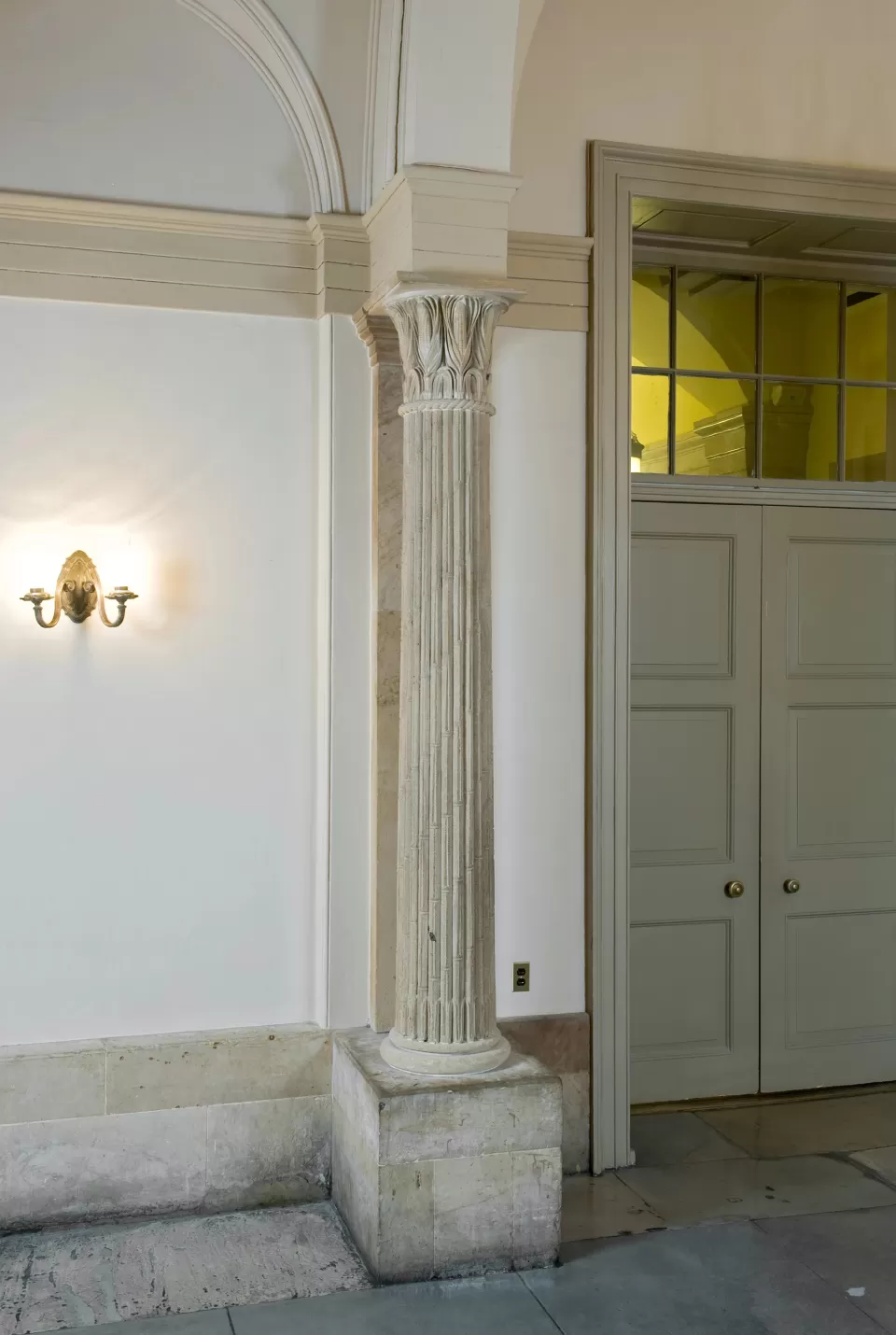Highlights
Some of the oldest and most famous interior features of the Capitol are located near the entrance to the Old Supreme Court Chamber. These six corncob columns, designed ca. 1808 by Benjamin Henry Latrobe, are among the most unusual and significant architectural works of the early Republic.
In 1803, Congress appropriated $50,000 to continue construction of the Capitol, which then was not yet one third complete. Only the north wing was standing at the time, and its construction had been hastily concluded and poorly managed. The new appropriation was used not only to begin the south wing but also to repair the already deteriorated north wing. To undertake these tasks, President Thomas Jefferson turned to Benjamin Henry Latrobe, an architect and engineer of uncommon talent and experience. Upon examination of the north wing, Latrobe concluded that, to effect a permanent solution to its problems, the north wing should be gutted and its interior rebuilt using solid, fireproof, vaulted construction. The President agreed with Latrobe's plans but cautioned him not to proceed until the south wing was ready to receive the House of Representatives.
In 1808 Latrobe was ready to reconstruct the interior of the north wing. For the east entrance, he planned to replicate approximately its existing shape, with a curving south wall, but he reduced its width to better accommodate the vaults that would form its ceiling. To carry the weight of these vaults, Latrobe found it necessary to provide six sandstone columns standing on new foundations. In this way the new columns, rather than the old walls, would bear the weight of the vaulted ceiling.

Once he determined that supporting columns would be needed, Latrobe then, with creative insight and courage, invented a new American order of architecture: the so-called corncob column. Characteristic of Latrobe's best work, these indispensable structural members take the form of elegant, original, and fitting designs.
The columns stand 8 feet 92 inches tall and were carved from monolithic blocks of sandstone quarried at Aquia Creek, Virginia. Giuseppe Franzoni, one of several Italian sculptors working for Latrobe, is credited with the actual carving. The capitals are the most distinctive features of the columns. They are formed into a series of ears of corn, with the husks gently and evenly folded back to reveal the kernels within. Cornstalks form the shaft of the column. Rope-like carving serves as a necking that appears to bind the cornstalks together. Latrobe's design is deceptively simple and graceful. After seeing these columns, Mrs. Trollope noted in her Domestic Manners of the Americans (1832) that "A sense of fitness always enhances the effect of beauty."
With obvious pride, Latrobe wrote to Thomas Jefferson, then in retirement at Monticello:
I have packed up & sent to Richmond to be forwarded to Monticello a box containing the Model of the Capital of the Columns of the lower Vestibule of the Senatorial apartments of the North Wing of the Capitol; which is composed of Ears of Maize. On a short frustum raising it about 4 feet from the Ground it may serve for a Dial stand.... This Capital, during the Summer Session obtained me more applause from the Members of Congress than all the Works of Magnitude, of difficulty & of splendor that surround them. They christened it, the Corn Cob Capital, whether for the sake of alliteration I cannot tell, but certainly not very appropriately.
— [August 28, 1809, (Jefferson Papers, Mss. Div. LC) reproduced by the Papers of Benjamin H. Latrobe Microtext Edition.]
On November 5, 1816, Latrobe again wrote to Jefferson about the columns, describing their condition after the burning of the Capitol by the British in 1814:
The Columns & Capitals as executed, and standing in the Vestibule of the North wing of the Capitol on the Ground floor, were not much injured by the British, so little indeed that—as I wish some part of the building to remain as they left it—I do not propose to repair them, unless the president shall order it to be done.
— [Jefferson Papers Mss. Div., LC. reproduced by the Papers of Benjamin H. Latrobe Microtext Edition.]
Latrobe's design continued to excite comments and admiration despite changing taste. The architectural historian I. T. Frary wrote in 1940:
His fertility of imagination is well illustrated in the capitals and columns which he designed for the ground floor lobby and the small rotunda of the Senate or north wing of the Capitol. In the former he deserted the two thousand year old tradition of loyalty to the acanthus leaf, and bestowed his artistic affections on the lowly cornstalk. His 'cornstalk' or 'corncob' capitals are among the most unique features of the great Capitol and are the delight of all who are fortunate enough to discover them and appreciate their individuality. In them Latrobe made a distinctly original contribution to decorative design and as might be expected from a man with his ability and discriminating taste, he did it well.
— [They Built the Capitol, p. 80]
In spite of their popularity, the corncob columns never became a mainstay of American architecture. Latrobe's brilliant design was rarely, if ever, imitated. Only the mid-nineteenth-century architect A.J. Davis seems to have found inspiration in these columns for his design of the Smith-Playmaker Theater at the University of North Carolina (built in 1849–1852).
While many visitors expressed delight with the corncob columns, they preferred the ancient orders of Greece and Rome when designing their own buildings. This aspect of Latrobe's contribution to American design is one of the more curious enigmas in architectural history.
